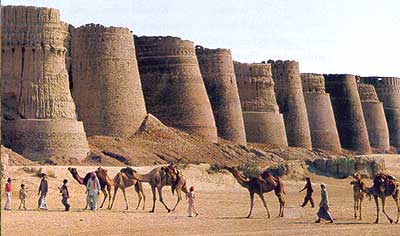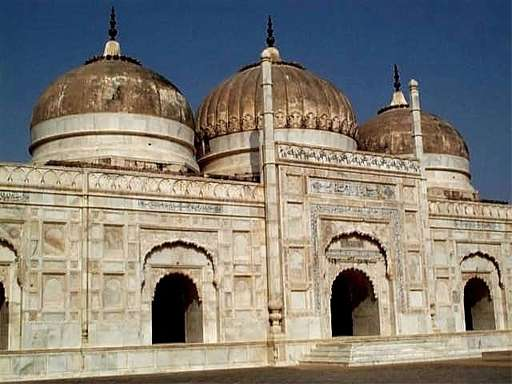The historic Derawar Fort, enormous and impressive structure in the heart of Cholistan desert, is rapidly crumbling and if the immediate preventative measures are not taken, the edifice will be destroyed and the historians, researchers and sightseers deprived of the view of the legacy of the bygone era. Like so many other historic sites in the country, Derawar Fort is yet another sign of old times we are poised to loose forever due to the apathy of those who are responsible for its upkeep and preservation.

Before it disappears, once again, I was on my way to Cholistan: the place that is crucible of one of the world’s oldest civilization, where some of the past secrets are hidden, where history is still active.
Derawar is the oldest fort and the only perennial water-hole in the area. But a visit to the Fort is painful for those locals or foreigners who value the heritage and other signs of past eras. They are disappointed with its fate and neglect of its wonders. Neither is it being maintained as a tourists’ attraction, for which it has good potential, nor as a historical and archaeological monument. Result: the days do not seem far when the Fort would be converted into a sand dune. Main entrance and ceiling have developed cracks. Most of its buildings and portions, which had been an abode of the Abbasi Nawabs, are already in ruins. The three-story fort is now without any story. There are also ditches in it which can be dangerous for anyone not walking with care. At least the boundary walls and the main gate of the fort can still be preserved so that something is left as an evidence of the past. The monument has architectural, historic, documentary, and symbolic values. Remain of the monument have to be preserved and saved from total ruination, a danger they are facing at present.
The Fort was built by Deoraj, a prince of Jaisalmir. It was in possession of royal family of Jaisalmir when it was captured by Abbasis in 1735. As per Bahawalpur Gazetteer (1904), in 1747 the Fort slipped from the hands of Abbasis in the reign of Nawab Bahawal Khan due to his pre-occupations at Shikarpur. Nawab Mubarak Khan took the stronghold back in 1804.
The lofty and rolling battlements made of thin red bricks, ten on each side of the fort are visible from miles around. The circumference wall is about 40 meters high. There are two old vintage guns mounted on pedestals in the dusty courtyard of the Fort. On the western side are small under ground cells now infested with bats and wood being eaten by termite. As per the fable the secret to change metal into gold was told to Prince Deoraj by his guru Yogi and there still is a treasure hidden somewhere in the Fort. (This idea keeps coming to me again and again: what if I can find the hidden treasure?) Nawab Bahawal Khan constructed a mosque with cupolas and domes of exquisite marble in 1849. It is a replica of Moti Mosque, Delhi. As per the legend there are some graves near the fort, which are said to be of the companions of the Prophet Muhammad (PBUH) and the other Muslim reformers who rendered great services to spread the light of divine Islam in the area. A few hundred yards from the Fort in a hall with engraved doors in witch Abbasi Amirs and their families are buried: Nawab Muhammad Bahawal Khan (2nd), Nawab Sadiq Muhammad Khan (2nd), Nawab Muhammad Bahawal Khan (3rd), Nawab Fateh Muhammad Khan, Nawab Muhammad Bahawal Khan (4th), Nawab Sadiq Muhammad Khan (4th), Nawab Muhammad Bahawal khan (5th), and Nawab Sadiq Muhammad Khan (5th), Sahibzada Abdullah son of Nawab Sadiq Muhammad Khan (5th), Rahim Yar Khan son of Nawab Sadiq Muhammad Khan (4th) are prominent among those buried there. There are graves of the ladies of the Abbasi family in the north-western corner.
On the way to Derawar, pass Shahi Wala and Burji 42 Hazar and start thinking of Cholistan as an idea for which no language has an apt word, something waiting to be discovered in some out-of-the-way place, difficult to access, if one is enterprising enough to go out and look; an indefinite thing, taking different shapes in the minds of different individuals according to their interests and wishes.
“Derawar itself is considered as pre historic and pre Harappan settlement. It survived not only during pre Harappan period but also afterwards,” says contemporary historian and researcher Nurul Zaman Ahmad Auj, “The fact that it was the first settlement of Indo-Scythian race also points to the antiquity of the place. The settlement existed when Alexander crossed the Hakra River near Derawar. It was one of the important boarder posts of the caravan route and lastly was the capital of Bahawalpur State. Abbasi rulers turned the Hindu city into a perfect Muslim metropolis.”

Leaving the road and the four wheels driven jeep at Derawar, it was while exploring beyond that I found a few of the desert realities. Aside from wildlife, scenery, big solitude, and nomad culture, Cholistan also offer plenty of wind. The rippled shadows of the landscape dissolve at midday, and then deepen again in the afternoon. You find the sense of isolation. The faint white ridge line that marks the far edge drops beneath the horizon and one finds himself adrift in a sterile sea of yellow dunes. Inspired by the gorgeous absence of everything but curves and light, get in the utter emptiness of the landscape and vividly see slight details: telltale irregularities in the texture of the sand; the metallic ping of the odd pebbles beneath feet; a lone big black ant marching up a dune, its abdomen tilted skyward, lizard (Kirla) raising head to look at you from the distance and then rushing to the sanctuary of a bill in hurry, camels marching in perfect order or grazing on shrub called Katran. There is a complete lack of odour in the air.
There is an inland dry delta southwest of Fort Derawar. Some researchers are of the opinion that this is the place where the Hakra River ended centuries ago. The presence of the delta suggests that all, or most, of the River’s water was sopped up in this area where it would have been used for intensive agriculture and other pastoral needs. There seems to have been enough water to support intensive agriculture but not enough to push through to the Arabian Sea. However, a second group of experts holds the opinion that the Hakra River did reach the Arabian Sea. Both the groups have substantial data to prove their points.
At night, walking through the desert under the light of the moon was quite similar to hiking the dunes in daylight. The only difference was that the air was cool, the sand was gray and the Milky Way was more clearly defined in the sky. Later at night, footfalls did not sound like they were coming from my own feet any more; I kept turning around to see if I was being followed. Even sudden patches of soft sand would give me an occasional start in the dim silence.
Eventually, my paranoid habit of veering caught up with me, when – just short of midnight – I found familiar Jeep tyre marks in the sand. Since I had been walking what I thought was east for nearly eight hours, I had been circling around the same set of dunes near the Fort.










beutifully written..thanks for sharing..very informative
It should be a must visit by architectural degree students. The conservation firms must find a sponsor( privately) and save this beautiful fort from turning into dust. Some public involvement however is necesaary for giving NoCs and documentation. In present time what more you can ask the government to do:P The Baltit fort in Hunza was conserved and renovated by Aga Khans very impressively and I think Nawabs still can put together considerable funds to do a similar or better job for Derawar fort.
perfectly put together
could u give me more details on why Derawar is called the center of Dravidian culture by Mr.Auj?